Unraveling the Mythical Journey of Telemachus: A Hero's Quest
Telemachus, a central character in Homer's Odyssey, has an important role in Greek mythology as more than just the son of Odysseus and Penelope. His story is one of growth, wisdom, and heroism. He embarks on a journey to find his father who has been absent from his life since leaving to fight in the Trojan War.
While Odysseus struggles to return home after the war, Telemachus faces his own set of challenges, including dealing with suitors vying for his mother's hand in marriage. Athena, the goddess of wisdom, plays a crucial role in guiding Telemachus on his quest to find his father.
In this blog post, we take a look at Telemachus' parentage, his adventures in searching for his father and the impact of Odysseus’ absence on his upbringing. Without further ado, let’s get straight to the point.

The Lineage of Telemachus: Son of Odysseus and Penelope

Farewell of Telemachus and Eucharis - Credits: everettcollection/ Canva
Parentage and early life
Telemachus was born to Odysseus and Penelope in Ithaca, before the Trojan War. Odysseus was a Greek hero, famous for his role in Greek mythology , while Penelope was a virtuous and loyal queen. As a child, Telemachus was raised by his mother, who instilled maternal wisdom in him while his father fought in the war.
Growing up in Ithaca, his early life was mostly spent within the palace, learning about his heritage and understanding his dual legacy, from both his father and mother. As he reached manhood, Telemachus became increasingly aware of his parents' importance and the responsibility that he would one day bear.
Impact of Odysseus' absence on his upbringing
Odysseus' prolonged absence due to the Trojan War and his subsequent odyssey had a significant impact on Telemachus' upbringing. Without his father's guidance, he relied on maternal wisdom and his father's loyal friends for support. His mother, Penelope, remained steadfast in her loyalty to Odysseus , teaching Telemachus the value of patience and resilience.
In the years that followed, Ithaca became overrun with suitors seeking Penelope's hand in marriage, believing that Odysseus was dead. Despite the hardships and challenges, Telemachus managed to maintain his composure and displayed wisdom, patience, and courage - traits inherited from both Odysseus and Penelope.
He eventually embarked on a journey to find his father and restore order to their kingdom, embracing the paternal legacy bequeathed to him.
The Call to Adventure: Telemachus' Quest Begins

Telemachus finds himself troubled by the presence of aggressive suitors vying for his mother's hand in marriage. This predicament sets the stage for his own journey in the ancient Greek epic, the Odyssey.
In this critical phase of his life, Telemachus is introduced to the goddess Athena, who disguises herself as his father's old friend, Mentes. In their very first encounter, Athena plants the seed of adventure within the young prince, telling him his father is still alive.
The characteristics of Telemachus' quest are as follows:
- Mentorship and Guidance : Throughout his journey, Athena serves as his mentor and protector, assisting him in various forms, whether it's supporting his decisions or providing him the tools for his success.
- Facing Challenges : Telemachus must overcome the resistance from suitors, elders, and even his own mother Penelope, who are hesitant about him embarking on this perilous journey.
- Growth in Character : As the son of a hero, Telemachus learns to embrace his youth, assert himself, and establish his own identity and responsibilities as a rightful prince. His tale highlights the importance of resilience and self-discovery.
Telemachus' journey eventually leads him on a quest for knowledge about his father, Odysseus' whereabouts, and ultimately a reunion with his long-lost father. By navigating the challenges and obstacles in his path, he gradually emerges as a more knowledgeable and confident individual.
Your Dream Family Vacation in Greece Starts Here Duration Group Type Check the calendar
In this captivating story that unfolds in parallel to Odysseus' own trials, readers of the Odyssey are guided through the fascinating evolution of Telemachus, from a timid young man to a more assertive and responsible prince. The call to adventure and the influence of a mentor like Athena help shape Telemachus into a Greek hero of his own.
Trials and Tribulations: Challenges Telemachus Faced
Telemachus, the son of Odysseus and Penelope, embarked on a journey filled with challenges throughout Homer's epic poem, The Odyssey. As a young man growing up in a world of Greek mythology, his early life was marked by the absence of his father, who had been away at the Trojan War for nearly two decades.
One significant challenge faced by Telemachus was dealing with the suitors who overran his household, harassing his mother Penelope and consuming the family's resources. Telemachus was unsure how to protect his family and home. Without a father figure or mentor, he struggled to find a way to assert his authority and defend his family's honor.
Thankfully, Athena, the goddess of wisdom, took an interest in the young prince and guided him on a quest to discover his father's fate. Telemachus traveled to the courts of Nestor and Menelaus, who shared their knowledge and advice with him.
Upon returning to Ithaca, Telemachus faced a vicious ambush orchestrated by the suitors; they sought to kill him before he could reassert his position as the rightful heir. With the help of deus ex machina and his now cunning mind, he managed to thwart their attack.
Telemachus was also instrumental in a climactic battle alongside his father, Odysseus. Together, they triumphed over the oppressive suitors, reclaiming their household and restoring honor to their family. These hardships forge him into the strong, capable leader that he had always aspired to be.
The Return: Telemachus' Reunion with Odysseus

In Greek mythology, the reunion between Telemachus and his father, Odysseus, holds a significant and emotional place in the story of the Odyssey. As the son of the legendary hero Odysseus, Telemachus has grown up without his father's guidance, and in his absence, his home has been invaded by unruly suitors seeking to marry his mother, Penelope.
Telemachus sets out on a journey to gather information about his father, guided by the wise Goddess Athena. During his travels, Telemachus matures and learns about his father's adventures, as well as the need for bravery and loyalty. He attends an Assembly in Ithaca, where he addresses the Elders and gains their respect and support.
Meanwhile, Odysseus returns to Ithaca in disguise, aided by Athena. He stays with Eumaeus, a loyal and humble swineherd, who is unaware of the true identity of his guest. It is in Eumaeus' hut that the long-awaited reunion between Telemachus and Odysseus finally takes place.
Upon arriving at the hut, Telemachus initially mistakes his father for an old beggar. However, with the help of Goddess Athena, Odysseus reveals his true identity to his son. Their emotional reunion is marked by tears of joy and relief, as they realize that they can finally stand together against the suitors.
Key elements of the reunion:
- Telemachus' journey of self-discovery
- Odysseus' return to Ithaca in disguise
- The emotional moment of recognition
- The strengthened bond between father and son
Telemachus and Odysseus' reunion signifies the importance of loyalty and trust in their relationship. They join forces, and with Athena's guidance, they plan their revenge on the suitors who have disrespected their home and family.
In conclusion, the reunion of Telemachus with Odysseus is a pivotal moment in the Odyssey, demonstrating the importance of family, loyalty, and perseverance in the face of adversity.
In wrapping up the mythical journey of Telemachus, it is evident that his story is a quintessential coming-of-age tale that has resonated through the ages. The growth and maturation of Telemachus, from a passive observer in his own home to an assertive and wise leader, reflect the universal challenges of growing up and finding one's place in the world.
His journey, under the guidance of Athena, showcases the transformation from boyhood to heroism, a narrative that continues to inspire modern interpretations and adaptations.
7-Day Percy Jackson Mythology Trip Duration 7 days Group Type Private Check the calendar
Telemachus' legacy in Greek literature is significant; he symbolizes the potential within all young people to rise above their circumstances through courage, wisdom, and perseverance. His adventures and trials contribute vitally to the central plot of the Odyssey, intertwining his fate with that of his father, Odysseus, and highlighting the enduring bonds of family and loyalty.
Who is Telemachus in the Odyssey, and what role does he play?
Telemachus is the son of Odysseus and Penelope, and a central character in Homer's Odyssey. As his father embarked on his journey to Troy, Telemachus was just an infant. He grows up devoted to his mother and maintaining his father's estate. During the events of the Odyssey, Telemachus embarks on a journey to find his wandering father and faces challenges that reveal his own growth and maturity as a hero.
How is Telemachus's relationship with Athena portrayed in the Odyssey?
In the Odyssey, Athena, the goddess of wisdom and war, takes a keen interest in Telemachus. She guides and advises him throughout his journey, giving Telemachus the courage and wisdom to stand up against the suitors and search for his father.
What does the character of Telemachus symbolize in Greek literature?
Telemachus's character represents growth, maturity, and the transition from boyhood to manhood. His journey to find his father and the challenges he faces along the way symbolize the universally relatable struggles of self-discovery, forging an identity, and finding one's place in the world.
How did Telemachus contribute to the events in the Odyssey?
Telemachus plays a pivotal role in the Odyssey by embarking on a journey to locate his father and gather information about his possible fate. While he does this, he also learns valuable life lessons and develops his skills as a leader. Telemachus ultimately helps Odysseus to reclaim their family's estate from the suitors who have overrun it in his absence.
Top 10 Athens Accommodations: Where to Stay in Athens
Unveiling the mysteries of demeter - the goddess of agriculture in greek mythology, sirens in greek mythology: enchanting tales of temptation and danger.
- Corrections
Telemachus: The Original Greek Coming of Age Story
Telemachus was a young Greek hero whose adventures are seen as the Greek version of the coming-of-age story. Read on to discover his adventures from childhood to adulthood.

The coming-of-age narrative arc is a popular and widely recognized theme for storytelling. Telemachus had a famous father — Odysseus — who traveled most of the known Greek world, generating many fascinating myths. Likewise, Telemachus himself had many adventures on the journey to adulthood. The first four books of the Odyssey are also known as the “Telemachy” as they relate to the story of the young hero’s travels in search of news about his father. Parallels with the modern conception of the coming-of-age narrative are clear. In this story we can see the basis of the genre — its birth lies in Greek myth.
Who is Telemachus?

Telemachus was the son of Penelope, and Odysseus, who ruled the kingdom of Ithaca in ancient Greece. His name means “far from battle” which alludes to his first appearance in Greek myth as a baby who Odysseus had reluctantly left behind to go to war far away on the plains of Troy . Odysseus did not return home for another twenty years and his story is told in the Odyssey .
Telemachus was born to Penelope and Odysseus just before the outbreak of the Trojan War. When recruiters came to summon Odysseus to the war, he pretended to be mad; he attached an ox and a donkey to his plow and began driving up and down the fields in a frenzy. When a man named Palamedes took Telemachus from his crib and placed him in front of the plow, Odysseus immediately ceased the act to protect his son. In another version of the myth, when Odysseus was feigning madness, Palamedes snatched Telemachus from Penelope’s arms and drew his sword as if to kill the baby. Odysseus then confessed his act in order to stop Palamedes from killing his child.
Telemachus grew up without his father in the picture. At home, he lived with his mother, Penelope, but their house was soon invaded by suitors who wished to marry Penelope in Odysseus’ absence. As a result, he had to endure the rude behavior of the suitors who insulted him and refused to listen to the young boy in his own house. Coming-of-age stories often begin with a turbulent time — for Telemachus, this was the suitors, who were squandering his home. The protagonist often wishes for a way to change their situation, and so this young man dreams of changing life on the island.
Athena: An Immortal Guide

Get the latest articles delivered to your inbox
Please check your inbox to activate your subscription.
Telemachus did have one advantage on his side: the goddess Athena . In Greek mythology, Athena was the goddess of wisdom, skill, and war. She appears in many Greek myths helping heroes (such as Perseus , Achilles, and Odysseus) giving them wise advice.
Athena was also the patron goddess of the House of Odysseus due to the family’s propensity for intelligence. Athena particularly favored those with a keen and intelligent mind, and she saw potential in Telemachus. Role models are a key feature of coming-of-age stories. The need for someone to look up to, a trusted advisor, is key for the development of the psychological and social relations of adolescents moving into adulthood. Athena takes this role.
Athena disguises herself as a family friend named Mentor, which is where the modern word “mentor”, comes from. In this form, Athena gives valuable advice and guidance to Telemachus. As a goddess who symbolized wisdom, she often inspires the development of wisdom in mortals. It is apt then that Athena is involved in the life of our young hero, whose youth is of particular importance — he is still developing the wisdom that Athena so admires in his father, Odysseus.
Telemachus and the Suitors
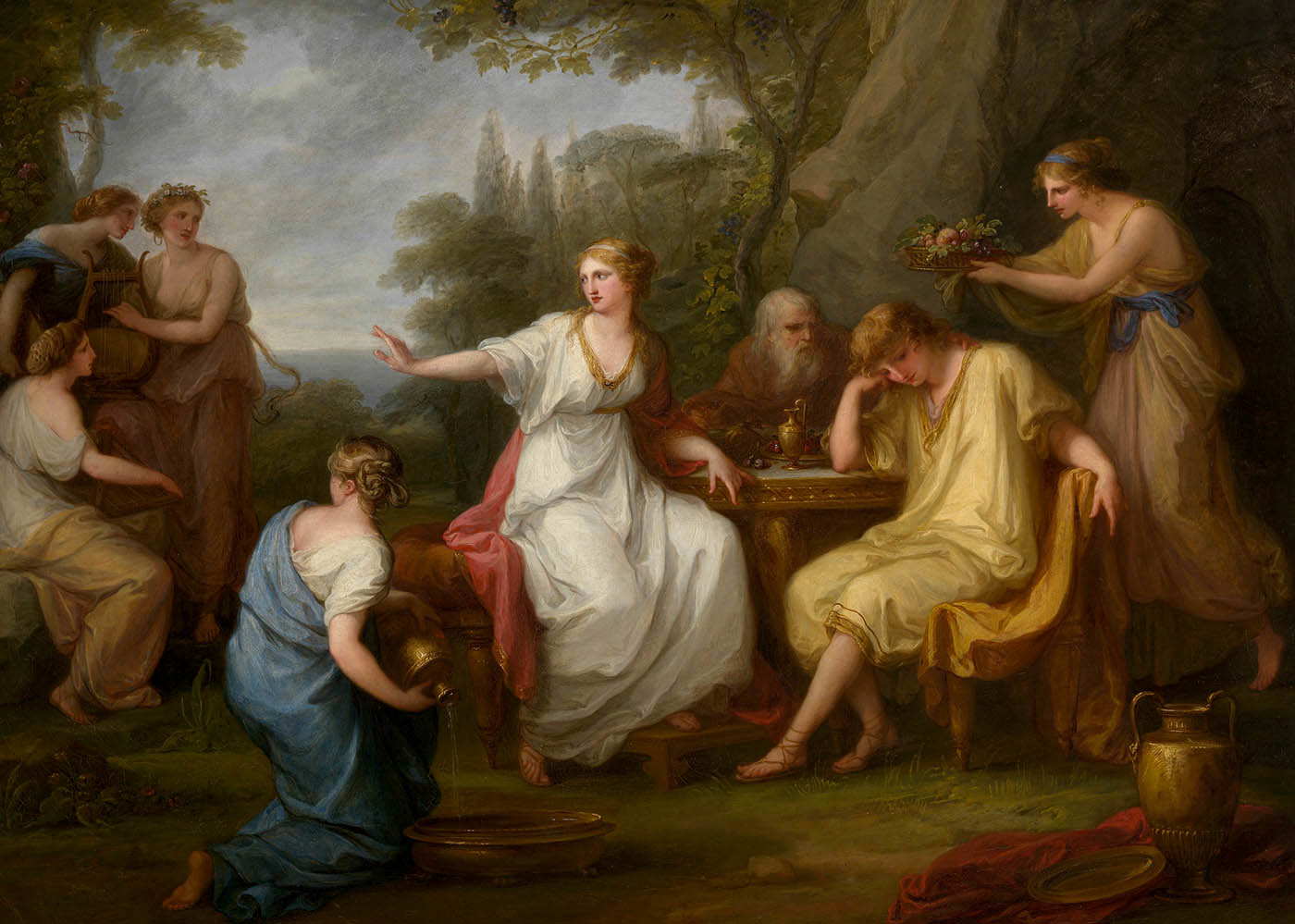
In the Odyssey , Telemachus is first introduced as an inexperienced teenager, lost in his own thoughts . He despairs due to his lost father, the grief of his mother, and the disrespect from the suitors, who are plundering his house and hounding his mother with marriage proposals when his father is not even confirmed dead.
He was just one young man against 108 suitors, fully-grown men. These men had taken up residence in his house with designs to marry Penelope. Therefore he was in a fragile position: if his father was confirmed dead, he could rightfully claim his title as heir and head of the household. But Telemachus could not confidently claim this, because Odysseus’ whereabouts were unknown, and Penelope’s son was unsure how to get rid of the suitors by himself.
In one attempt to disperse the suitors, Telemachus organizes a meeting for the elders of the island to discuss the suitors’ bad behavior.
“My distinguished father is lost… My home and all I have are being ruined. My mother wanted no suitors but like a pack They came— […] They squander everything… Expel them, yes, if only I had the power… My house is being plundered: is this courtesy? Where is your indignation? Where is your shame?” ( Odyssey 4.49-80)
Some of the elders are impressed with Telemachus’ speech, but the suitors rudely mock him for his youth and inexperience. As a result, his speech is unsuccessful, and he is placed in an even worse position; the suitors hate him even more and secretly make plans to kill him. He is encouraged by Mentor-Athena to set out on a journey to discover news about his father. According to Athena’s standards, Telemachus must first gain knowledge, to increase his strength, before finally returning home with the ability to defeat the suitors.
Telemachus’ Travels

Telemachus and Mentor-Athena set off on a journey to visit the great kings of Greece, who were old friends and comrades of Odysseus. This is the beginning of the hero’s coming-of-age narrative. His first stop is at the kingdom of Nestor , in Pylos. Just before getting off the ship, he hesitates, doubting his skill at speech and worrying that he will appear rude and uneducated to Nestor.
“Mentor, how can I do it? How approach him? I have no practice in elaborate speeches, and For a young man to interrogate an old man Seems disrespectful…” ( Odyssey 3.22-25)
This self-doubt is key to the coming-of-age trope; many characters in this narrative begin with doubt and grow in confidence as they learn from new experiences. Mentor-Athena notices his uncertainty and tries to rouse his confidence. Athena assures him that he has the ability: “reason and heart will give you words, Telemachus, and a spirit will counsel others.”
And so, Telemachus approaches Nestor and asks about his father. Nestor is very impressed with the young man’s speech — he praises him for having the eloquence of his father. This is a very high compliment as Odysseus was known among the Greeks for his silver-tongue. Among other things, Nestor teaches Telemachus about the importance of loyalty, and faith in the gods. This enhances the young protagonist’s psychological growth as a maturing young man.
After this, Telemachus visits King Menelaus and Queen Helen , who live in Sparta. Here he learns that his father is alive but trapped on the island of Calypso. Menelaus also admires the likeness of Odysseus in Telemachus, which helps him gain confidence in his parentage, which he sometimes doubts. Inspired by the news that his father is alive, Telemachus is reinvigorated with hope and self-assurance.
Return Home: Reunion with Odysseus
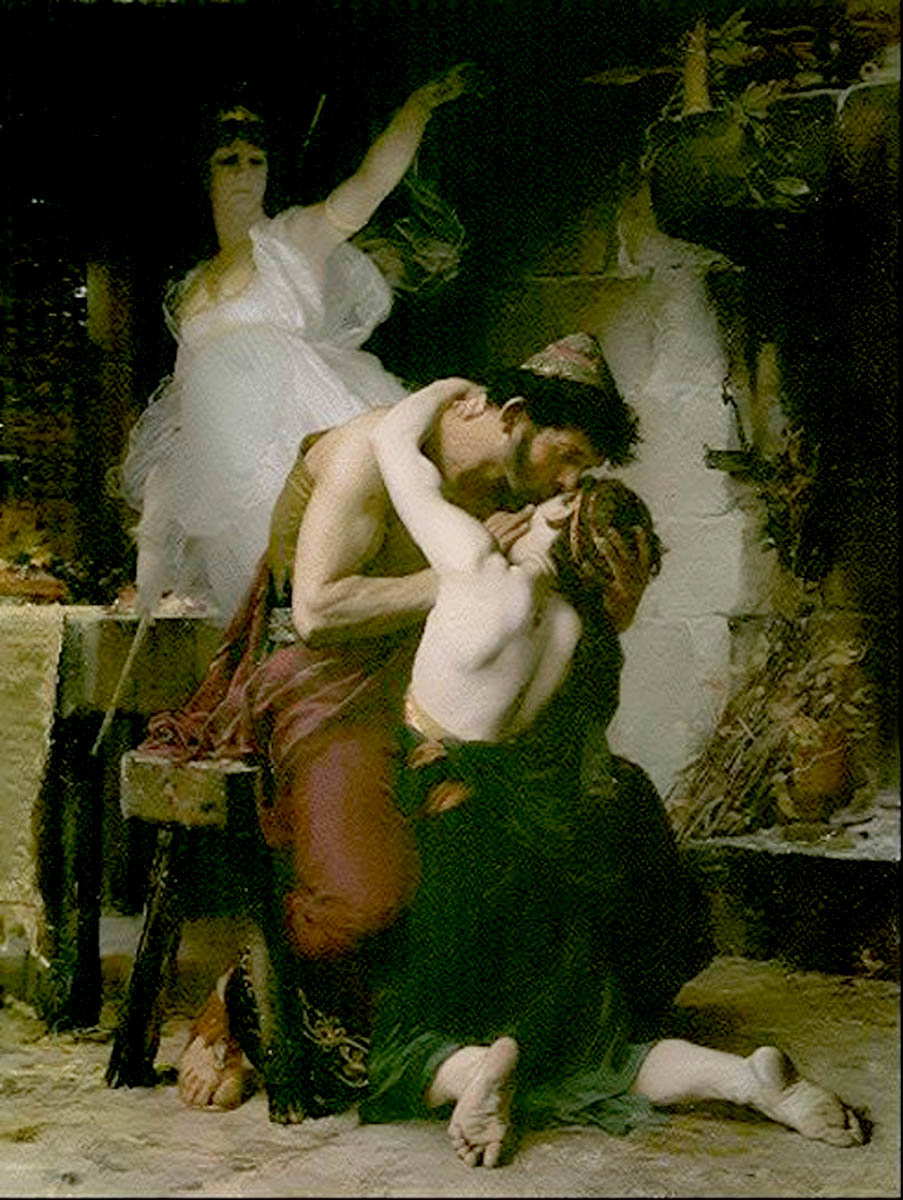
Whilst Telemachus had been traveling, the suitors had been plotting “the death plunge for Telemachus.” ( Odyssey 4.897) Telemachus avoids the ambush that he had expected by taking shelter with a swineherd. Unbeknownst to Telemachus, his father Odysseus has also arrived from his twenty-year-long journey and is resting inside the same swineherd’s shelter. Odysseus is disguised as an old man — a magic trick courtesy of Athena.
Telemachus is gracious to the “old man” and shows the exemplary behavior of a young prince on the verge of adulthood. He accepts the responsibility of care for the old man but shows concern regarding his ability to keep his guest safe in his own home due to the presence of the violent suitors. During their conversation, Telemachus mentions how much he misses his father, which is heart-warming for Odysseus to hear.
“If men could choose, and have their choice, in everything, we’d have my father home.” (Odyssey 16.172-3)
Odysseus, having waited to gauge his son’s character, eventually reveals himself once he is proud of what he has seen. A happy reunion ensues.
“Then, throwing his arms around this marvel of a father, Telemachus began to weep. Salt tears Rose from the wells of longing in both men, And cries burst from both” ( Odyssey 16.252-6)
Reunited, father and son begin to devise a plan to eradicate the suitors and finally reunite their family.
Reuniting with Penelope
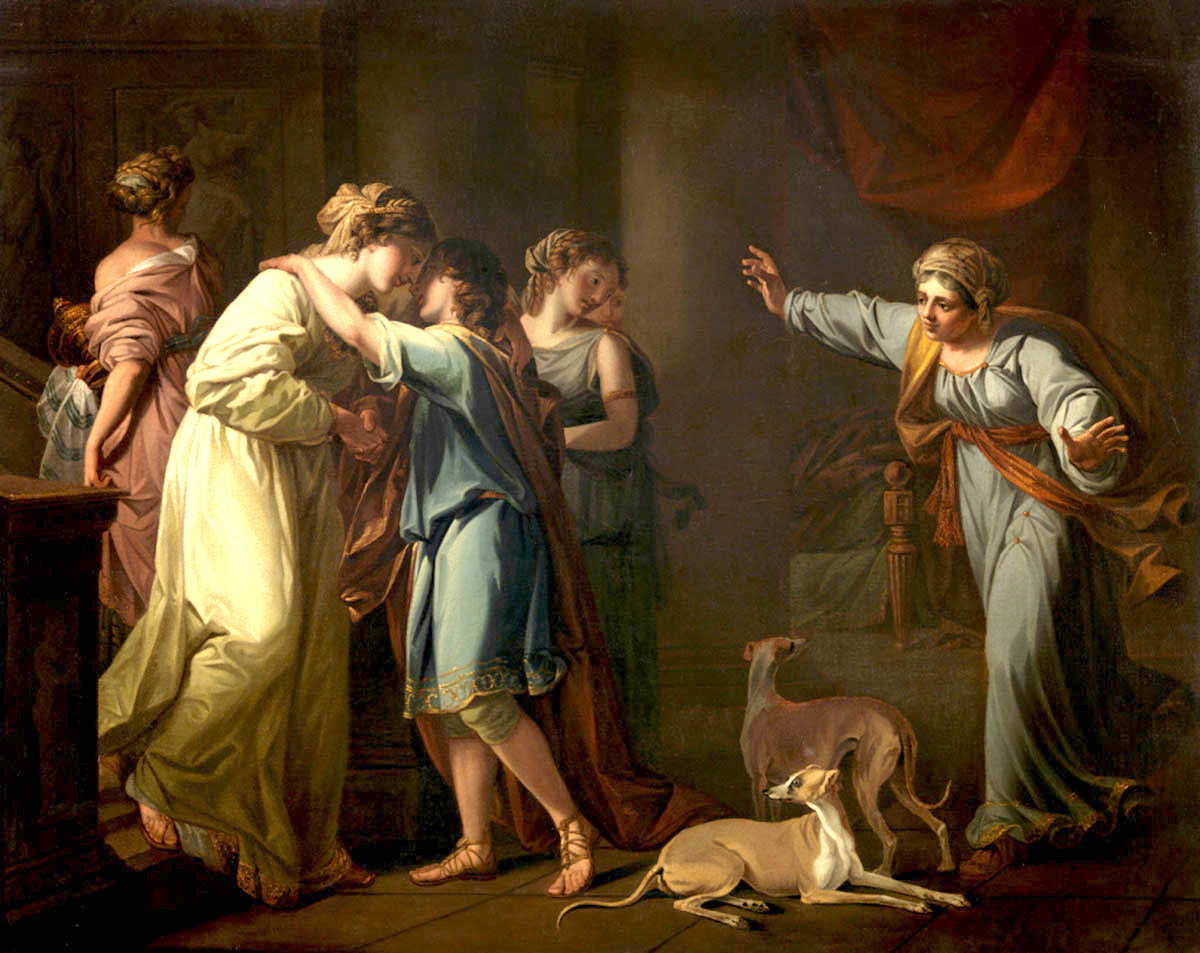
Odysseus (once again disguised) and Telemachus, keeping a low profile, return to the palace. Once there, Telemachus secretly creeps into the palace and gathers weapons. He stores them in a hidden but accessible location so that they can arm themselves against the suitors when the time is right.
First, Penelope is reunited with Telemachus. He shows personal growth — key to coming-of-age narratives — in his improved attitude towards his mother. At the beginning of the story, he appeared impatient and brusque, chiding her for her laments. However, Telemachus’ attitude towards his mother changes by the time he returns home. He shows newfound respect for her, being courteous and apologetic.
“Mother… I know the meaning of these actions now, both good and bad. I had been young and blind.” ( Odyssey 18.283-6)
Telemachus also shows concern for her mental health; one of his first thoughts when reaching the island is a desire to let Penelope know that he and Odysseus are alive so that she will not despair. He later shows a protective attitude concerning his mother. In one scene, he commands Penelope to leave the courtyard and return to her room to continue her weaving. He then has her locked in the room. This appears to the onlookers as if Telemachus is being rude, however, Telemachus knows that a battle is about to commence, and so his actions ensure that Penelope is out of danger, and as safe as possible.
Reclaiming Home

In the courtyard, Telemachus sets up the trial of the bow: Penelope had announced to the suitors that whoever could shoot an arrow through twelve ax-heads with Odysseus’ old bow, would become her new husband.
There is symbolism in Telemachus’ own attempt to fire the arrow. He fails three times to string the bow, but on the fourth attempt, it appears that he could have been successful. However, upon a secret signal from Odysseus, he retreats from the challenge. The plan was for the suitors to fail at the challenge, and for Odysseus to step up last and reveal his identity. Telemachus’ almost-victory shooting the arrow conveys how he has almost completed his passage from childhood to adulthood, and that he is undeniably the heir of Odysseus.
Once Odysseus completes the challenge, Telemachus and his father begin the purging of the suitors. It soon becomes apparent that the door to the room with the weapons has been left open, and the suitors are able to arm themselves. Without hesitation, Telemachus owns up to this mistake.
“It is my own fault, Father, mine alone. The storeroom door — I left it open. They were more alert than I.” (Odyssey 22.171-3)
His humble acceptance of his own mistake shows maturity, and his responsible nature speaks to his growth into adulthood. Nevertheless, with the magical aid of Athena, Odysseus and Telemachus are able to kill all the suitors in a violent battle.
Parallels with Other Coming-of-Age Narratives

A vital part of the coming-of-age storyline is the personal growth the protagonist experiences on the way to becoming an adult. In particular, Telemachus’ example highlights Homeric Greek society’s expectations of what psychological changes an adolescent may experience when growing up: self-doubt to confidence, arrogance to humility. Telemachus learns responsibility and respect.
Telemachus’ journey across the sea, from his hometown to mainland Greece, is considered dangerous. As such, the journey proves that he has grown in bravery. The physical journey reflects the psychological journey. A major part of Telemachus’ growth is about confidence. He begins the journey unsure of himself because he had been unable to send away the suitors, as they had overpowered him in the meeting. When first arriving at Pylos, this self-doubt almost stops him at the beginning of his journey.
With the support and encouragement of a role model (Athena in the disguise of Mentor) Telemachus is slowly able to overcome his insecurities. On his return, he is able to confidently assume his place in the household and rid his property of the suitors. Doubt does not hold him back this time.
Emotional responses are a huge part of growing up. Telemachus gets angry at his mother and the suitors at the beginning of the Telemachy — this is manifest frustration at an inability to claim independence and power in his own home on the brink of adulthood. However, on his return, his naive lack of appreciation for his mother has become humble respect. With regards to the suitors, Telemachus is able to calmly deal with them and claim his power in the house as the rightful heir of Odysseus.
A Hero’s Growth

By the end of the Odyssey , Telemachus has grown into a responsible young man who is accepting of his flaws and yet wise in his efforts to improve himself. The end of the Odyssey is by no means the end of Telemachus’ story, but the conclusion to his coming-of-age arc, and the beginning of his life as an adult.

Trojan War: The Epic Tale in 17 Artworks

By Bethany Williams BA Classics and English, MA Literature Bethany is a Masters student, currently studying the adaptation of Greek myth in modern literature. She is a graduate of Classics and English (BA), during which she studied Ancient Greek language, classical reception within its own time and throughout history, as well as Greek and Roman history. Apart from her studies, she has an appreciation for art, philosophy, and travel. She may be based in England, but her heart is in Greece.

Frequently Read Together

Homer’s Odyssey: The Epic Voyages of Odysseus in 16 Artworks

Minerva and Athena: Roman vs. Greek Goddesses of War

The Tragedy Of Greek Goddesses: Feminism In Ancient Greece
Telemachus Journey From Boyhood to Hero: Homer’s The Odyssey Essay
As described by Arnold van Gennep in “The rites of Passage,” the concept of the rites of passage is a ritual event used to signify the process of transition of a person from one social or cultural status to another (Gennep 23).
Arnold van Gennep states that the concept of rites of passage is a general socialization theory whose aim is to mark, describe, and note the milestones that an individual makes in his or her life. Van Gennep introduced the “three universal” phases for all the rites of passage- separation, transition (liminality) and incorporation (reintegration) (Mahdi, Christopher and Meade 36).
According to this concept, an individual must lose his or her identity in the stage of separation. An abrupt process ruptures an individual’s relationship with the members of the society, the family, and the community. In most cases, the person has to be alienated or move across social and geographical boundaries.
The transition phase is the intermediary period in which the individual, after losing the identity, is prepared for the final stage of incorporation back to the community. There is a lot of confusion, education, and testing, and the individual may lose name, language, disguise, or behavior (Mahdi, Christopher, and Meade 36). The final stage involves the movement of individuals from isolation by returning to the community but possessing a new identity.
In the initial stages, Homer presents Telemachus as a young and relatively weak individual. However, the reader is able to forecast Telemachus’ ability to exercise authority in his father’s household. In Book 1, Penelope (Telemachus’ mother) attempts to dictate the type of song to be performed for the 118 suitors in her household. However, despite being a minor, Telemachus is able to admonish her, which signals Telemachus’ future as a hero and respectable man in his society.
Nevertheless, despite seeing the economic and social destruction the suitors are making in his father’s house, Telemachus is not able to drive out them. Yet, he calls an assembly threatening to remove them. In fact, he accepts the fact that he is immature when he says, “I am a weakling… knowing nothing of valor” (Armstrong 131). It indicates his weakness and inability to fit the social definition of a hero. Therefore, a rite of passage is required to transform Telemachus from childhood to manhood and a hero or respectable man.
To achieve this, Telemachus must leave for Pylos and Sparta, specifically to search for his father. At this point, Homer attempts to describe a clear definition of the social definition of a respectable man- that of an individual who has a strong link with the father as well as an individual with courage and ability to undertake difficult and challenging tasks. Here, it is clear that the first stage of the rite of passage is presented- Telemachus must be separated from his family and society “to find his identity.”
While traveling through Sparta and Pylos, Telemachus must meet new societies, cultures, and traditions. He must learn new things and find a new identity, as described in Van Gennep’s concept. He learns of the Greek concept of social contract or “Xenia,” the relationship between the hosts and guests. The host must provide for the guests, but the guests must respect the host.
He also learns of his father’s cunning, heroic nature and braveness in the Trojan War. Here, Homer indicates that a hero or honorable man must be brave, courageous, and patriotic. In addition, he learns that Odysseus is alive, as described in the story by Menelaus, the king of Sparta.
In the final stage, Telemachus returns home after undergoing a two-year transition period in which he finds a new identity as described in Van Gennep’s concept. He leaves Sparta confident of himself and ready to face the suitors, who have already ganged up to ambush and kill him before he completes his rite of passage.
However, the transition period is accomplished, and the young Telemachus becomes a hero and a respectable man, thanks to the rite of passage. Therefore, it is clear that the rite of passage has been used as a transition period to make Telemachus fit into the Greek perception of an honorable man or hero.
Works Cited
Armstrong, Thomas. The Human Odyssey: Navigating the Twelve Stages of Life. New York: Sterling Publishing Inc., 2008. Print.
Gennep, van Arnold. The rites of passage . New York: Psychology Press, 2006. Print
Mahdi, Louise Carus, Nancy Geyer Christopher and Michael Meade. Crossroads: The Quest for Contemporary Rites of Passag e. New York: Open Court Publishing, 2010. Print.
- Short Summary
- Summary & Analysis
- Literary Devices and Symbols
- Questions & Answers
- Essay Samples
- Essay Topics
- Homer: Biography
- Chicago (A-D)
- Chicago (N-B)
IvyPanda. (2023, December 19). Telemachus Journey From Boyhood to Hero: Homer's The Odyssey. https://ivypanda.com/essays/telemachus-journey-from-boyhood-to-hero-homers-odyssey/
"Telemachus Journey From Boyhood to Hero: Homer's The Odyssey." IvyPanda , 19 Dec. 2023, ivypanda.com/essays/telemachus-journey-from-boyhood-to-hero-homers-odyssey/.
IvyPanda . (2023) 'Telemachus Journey From Boyhood to Hero: Homer's The Odyssey'. 19 December.
IvyPanda . 2023. "Telemachus Journey From Boyhood to Hero: Homer's The Odyssey." December 19, 2023. https://ivypanda.com/essays/telemachus-journey-from-boyhood-to-hero-homers-odyssey/.
1. IvyPanda . "Telemachus Journey From Boyhood to Hero: Homer's The Odyssey." December 19, 2023. https://ivypanda.com/essays/telemachus-journey-from-boyhood-to-hero-homers-odyssey/.
Bibliography
IvyPanda . "Telemachus Journey From Boyhood to Hero: Homer's The Odyssey." December 19, 2023. https://ivypanda.com/essays/telemachus-journey-from-boyhood-to-hero-homers-odyssey/.
- Sun Chief: The Meaning of Don Talayesva’s Journey with the Help of The Rites of Passage by Arnold van Gennep
- Hospitality in the Homer’s “The Odyssey” Epic Poem
- ‘Lost Names: Scenes from a Korean Boyhood’ by Richard Kim
- "Boyhood" Directed by Richard Linklater Review
- Greek Culture in Homer's "The Odyssey"
- "The Odyssey" by Homer
- Significance of the Rite of Passage: Maasai Lion Hunt
- “The Adventures of Tom Sawyer” by Mark Twain
- Family Relationship: Lawrence and Joyce
- “Araby” by James Joyce Literature Analysis
- Notes from the Underground by Fyodor Dostoyevsky Literature Analysis
- The Theme of Loneliness in Life in Literature
- Language, Identity and Constructions in Childrens' Literature
- "The Baron in the Tree" by Italo Calvino Literature Analysis
- The Prince' by Niccolo Machiavelli Literature Analysis
- Old World Gods
Greek Mythology Odysseus: The Epic Journey of the Brave Hero
In Greek mythology , Odysseus, also known as Ulisses, is a prominent character and the hero of Homer’s epic poem, the Odyssey. He was the king of Ithaca, known for his bravery, intelligence, and leadership.
Odysseus played a crucial role in the Trojan War and embarked on a journey filled with trials and adventures. Upon his return to Ithaca, he faced challenges at home but ultimately reclaimed his kingdom.
Odysseus’ story has become synonymous with epic journeys and courage.
The journey of Odysseus is filled with encounters with mythical creatures and tests of his strength and wit. From his confrontation with the Cyclops Polyphemus to navigating the treacherous Scylla and Charybdis , Odysseus overcame countless perils.
Back in Ithaca, he had to confront the suitors who invaded his home and prove his rightful place as the ruler. With the help of his son and the goddess Athena , Odysseus emerged victorious.
Sources and References: Various Greek texts, including Homer’s Odyssey, and scholarly books on Greek mythology .
Content of this Article
The Story of Odysseus in Greek Mythology
The story of Odysseus, the brave hero of the Trojan War, is a tale filled with adventure, resilience, and the triumph of the human spirit. From his valiant efforts in battle to his enduring love for his wife Penelope, Odysseus is a captivating figure in Greek mythology .
Let’s explore the different aspects of his story:
Odysseus: The Brave Hero of the Trojan War
Odysseus, also known as Ulisses, was renowned for his leadership, bravery, and tactical genius in the Trojan War. His clever strategies, such as the iconic wooden horse, played a pivotal role in the Greek victory over the Trojans.
Odysseus’s unwavering determination and unwavering loyalty to his comrades made him a true hero.
Odysseus’ Wife: Penelope’s Faithful Love
Penelope, Odysseus’s wife, exemplifies faithful love and resilience. During her husband’s long absence, she cleverly avoided the persistent suitors who sought her hand in marriage. Penelope’s undying loyalty to Odysseus and her unwavering hope of his return make her a symbol of devotion and steadfastness.
Odysseus and Circe : The Enchanting Sorceress
Download for FREE here our best selection of Images of the Mythology Gods and Goddesses!
Odysseus’s encounter with the sorceress Circe is a fascinating part of his journey. Circe , with her magical powers, lured Odysseus and his men to her island. However, Odysseus’s wit and cunning allowed him to outsmart Circe and secure his crew’s release from her enchantments.
This encounter highlights Odysseus’s ability to navigate treacherous situations using his intelligence.
Odysseus’ Son: Telémachus’ Journey to Manhood
Telémachus, Odysseus’s son, embarked on a transformative journey to seek information about his father’s fate. With the guidance of Athena , the goddess of wisdom, Telémachus traveled from island to island, encountering various challenges and learning important lessons.
His courageous pursuit of the truth showcases his growth from a young man to a capable and determined individual.
Throughout the story of Odysseus, his strength, intellect, and perseverance shine as he faces formidable obstacles and longs for his homeland.
The tale of his odyssey continues to captivate audiences, offering a timeless exploration of heroism and the human spirit.

The Journey of Odysseus
The Journey of Odysseus is a legendary tale filled with trials, adventures, and notable encounters. Throughout his arduous journey, Odysseus faced numerous struggles and triumphed over them with his wits and courage.
Trials and Adventures: Odysseus’ Struggles and Triumphs
Odysseus encountered a series of trials and adventures on his way back to Ithaca. From facing the seductive Lotus-Eaters to the perilous challenges posed by the Cyclops Polyphemus , each obstacle tested Odysseus’ resolve and resourcefulness.
His ability to outwit and strategize against formidable foes allowed him to overcome these challenges and continue his journey homeward.
Encounter with the Lotus-Eaters and Other Perils
One of the notable encounters in Odysseus’ journey was with the Lotus-Eaters, a group that tempted his crew with their addictive fruit, causing them to forget their mission. With his determination, Odysseus managed to rescue his men and move on to face other perils, such as the temptations of the enchantress Circe and the treacherous Sirens . Through his cleverness and steadfastness, Odysseus navigated through these dangers and forged ahead on his quest.
Confrontation with the Cyclops Polyphemus
One of the most famous episodes in Odysseus’ journey was his confrontation with Polyphemus , the Cyclops . In order to escape the clutches of the one-eyed giant, Odysseus devised a cunning plan.
By blinding Polyphemus , he managed to free himself and his companions, leaving the enraged monster helplessly searching for revenge. This triumph showcased Odysseus’ strategic thinking and bravery in the face of immense danger.
Navigating Scylla and Charybdis
As Odysseus sailed through treacherous waters, he encountered the dual perils of Scylla , a six-headed monster, and Charybdis, a deadly whirlpool. He had to make a difficult choice between risking the lives of his crew by sailing closer to Scylla or facing the threat of being devoured by Charybdis’ whirlpool.
Despite the inevitable loss, Odysseus made the strategic decision to navigate through Scylla ’s path, prioritizing the safety of his men. This moment exemplified his leadership and sacrifice for the greater good.
Odysseus’ journey was a test of his character and resilience. Each trial and encounter showcased his ability to navigate through adversity using his intelligence, bravery, and determination. The fascinating and epic tale of Odysseus’ journey continues to captivate audiences even in the present day, as his story remains an enduring symbol of heroic perseverance.
Return to Ithaca
After nearly a decade of trials and adventures, Odysseus embarked on his long-awaited journey back to his homeland of Ithaca. However, his return was not without its challenges.
Challenges at Home: Odysseus’ Battle Against the Suitors
Upon arriving in Ithaca, Odysseus discovered that his palace had been invaded by numerous suitors vying for his wife Penelope’s hand in marriage.
These suitors displayed disrespect and arrogance, consuming Odysseus’ resources and mistreating his loyal servants.
Odysseus, with the guidance of his son Telemachus, devised a plan to reclaim his kingdom. He disguised himself as a beggar and entered his own palace, observing the suitors’ behavior and testing their loyalty.
After proving his strength and skill, Odysseus engaged in a fierce battle against the suitors, ultimately emerging victorious.
Reunion with Penelope: True Love Prevails
Throughout his absence, Penelope remained faithful to Odysseus, resisting the suitors’ advances with unwavering devotion. When Odysseus revealed his true identity to Penelope, their reunion was filled with joy, relief, and love.
Their enduring love and trust served as a testament to the power of fidelity and the deep connection between Odysseus and Penelope.
Restoration of Odysseus’ Kingdom: Victory and Justice
Having vanquished the suitors, Odysseus set out to restore order and establish justice in Ithaca. He purged the palace of disloyal servants and punished those who had conspired against him and his family.
To solidify his authority, Odysseus revealed himself to the people of Ithaca as their rightful king. His reign brought prosperity, peace, and stability to the land he fought so hard to reclaim.
Odysseus in Greek and Roman Mythology
Odysseus, the legendary hero of Greek mythology , played a significant role in the Iliad and the Trojan War. His cunning tactics and strategic mind were instrumental in the Greek victory over Troy.
As depicted by Homer, Odysseus showcased his bravery and leadership skills in various military engagements, earning him a reputation as a formidable warrior.
Role of Odysseus in the Iliad and the Trojan War
In the Iliad, Odysseus emerged as a key figure among the Greek forces during the Trojan War.
Known for his diplomatic skills and eloquence, he played a vital role in several critical events, including the assembly of the Greek army, the reconciliation between Achilles and Agamemnon , and the strategic deployment of soldiers.
Odysseus’ clever plans and insightful advice contributed greatly to the final Greek victory.
Comparison of the Original Epic and the Odyssey
The Odyssey, a separate epic poem attributed to Homer, focuses specifically on the post-war journey of Odysseus. This remarkable narrative showcases his challenges and adventures as he attempts to return to his homeland, Ithaca.
Contrasting with the war-oriented Iliad, the Odyssey delves into the personal trials and transformations of Odysseus, highlighting his resilience, intelligence, and quest for self-discovery.
Influence of Odysseus in Ancient Greek and Roman Culture
Odysseus’ legend extends beyond the confines of Greek mythology .
His character had a profound impact on both ancient Greek and Roman cultures, serving as a symbol of courage, cunning, and the pursuit of journey and knowledge. Artists, poets, and writers drew inspiration from Odysseus, depicting him in various works of literature, art, and sculpture.
His name and story have become synonymous with bravery and resourcefulness throughout history.
Sources and References
When exploring the rich world of Greek mythology and the captivating story of Odysseus, it is important to refer to various reliable sources and references. These sources provide valuable insights and interpretations of the epic journey and heroic exploits of Odysseus.
1. Homer’s Odyssey : The primary and most influential source is the epic poem itself, written by the legendary poet Homer. It details the trials and tribulations faced by Odysseus during his ten-year journey back to Ithaca from Troy.
2. Ancient Greek Literature: Numerous ancient Greek texts, such as the works of Hesiod, Pausanias, and Apollodorus, provide additional information about Odysseus’ adventures, genealogy, and interactions with other mythical characters.
Ancient Art and Sculptures: The artwork and sculptures of ancient Greece offer visual representations of Odysseus and his renowned exploits, showcasing his cunning tactics and bravery on various vases, murals, and statues.
4. Classical Commentaries: Works by ancient scholars and philosophers, including Plutarch, Strabo, and Aristotle, offer valuable commentary and analysis regarding the character of Odysseus and the symbolic meaning behind his adventures.
5. Modern Interpretations: Contemporary literary works, critical essays, and academic research provide new perspectives and interpretations of the epic journey of Odysseus, shedding light on different themes and psychological aspects that relate to his character.
6. Archaeological Discoveries: Archaeological excavations in ancient Greek sites, such as Troy, Ithaca, and Mycenae, have unearthed artifacts and structures that provide tangible evidence and a deeper understanding of the historical context surrounding Odysseus and the world in which he lived.
7. Scholarly Books and Journals: Academic publications by experts in the field of Greek mythology and ancient literature provide comprehensive analysis, in-depth research, and scholarly discussions about Odysseus, his journey, and his significance within the larger context of Greek mythology .
By consulting these sources and references, we can delve into the fascinating world of Odysseus and gain a more comprehensive understanding of his adventures, his role in Greek mythology , and the enduring legacy he has left behind.
Gods and Goddesses By Pantheon
Challenge the gods in our quizzes, more than 3500 images a single click away.
Download any of our Mythology Bundles of the world!
Get your images here!
Breaking Down the Character Archetypes of the Hero’s Journey
You’ve read about George Lucas’s use of Joseph Campbell’s Monomyth found in his 1949 book, A Hero with a Thousand Faces , which is a common narrative pattern found in many stories from many different cultures worldwide. This narrative journey typically involves several character archetypes that affect the hero’s journey from beginning to end.
After the successful debut of Star Wars and Lucas’s discussions on using Campbell’s work as inspiration for his space opera, many producers, development executives, filmmakers, and screenwriters have explored the Monomyth with deeper and simplified approaches.
Christopher Vogler's Interpretation of the Hero's Journey
When Christopher Vogler, a development executive and screenwriter at Disney, was inspired by Joseph Campbell's concept of the story monomyth, he crafted a seven-page memo for Disney's development team and incoming screenwriters.
This memo, A Practical Guide to Joseph Cambell’s The Hero with a Thousand Faces , laid the groundwork for what would later become Vogler's 1992 book, The Writer's Journey: Mythic Structure for Storytellers and Screenwriters . In this book, Vogler expanded upon Campbell’s ideas.
He adapted Campbell's mythical story structure into twelve distinct stages (from Campbell’s initial seventeen). Our concise interpretations of these stages include:
- The Ordinary World : We see the hero's normal life at the start of the story before the adventure begins.
- Call to Adventure : The hero faces an event, conflict, problem, or challenge that makes them begin their adventure.
- Refusal of the Call : The hero initially refuses the adventure because of hesitation, fear, insecurity, or any other issues.
- Meeting the Mentor : The hero encounters a mentor who can give them advice, wisdom, information, or items that ready them for the journey ahead.
- Crossing the Threshold : The hero leaves their ordinary world for the first time and crosses the threshold into adventure.
- Tests, Allies, and Enemies : The hero learns the rules of the new world and endures tests, meets friends, and comes face-to-face with enemies.
- The Approach : The initial plan to take on the central conflict begins, but setbacks cause the hero to try a new approach or adopt new ideas.
- The Ordeal : Things go wrong, and added conflict is introduced . The hero experiences more difficult hurdles and obstacles, some of which may lead to a life crisis.
- The Reward : After surviving The Ordeal, the hero seizes the sword — a reward that they've earned that allows them to take on the biggest conflict. It may be a physical item or piece of knowledge or wisdom that will help them persevere.
- The Road Back : The hero sees the light at the end of the tunnel, but they are about to face even more tests and challenges.
- The Resurrection : The climax. The hero faces a final test, using everything they have learned to take on the conflict once and for all.
- The Return : The hero brings their knowledge or the " elixir " back to the ordinary world.
Within these stages are character archetypes that help to shape the hero’s journey, and their eventual character arc throughout the story.
Read More: Exploring the Twelve Stages of the Hero’s Journey
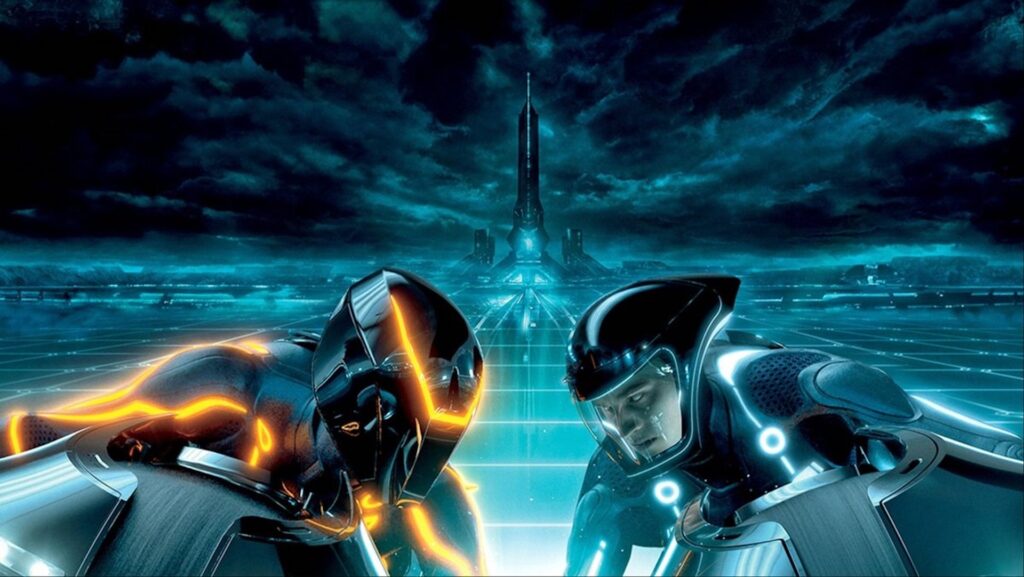
'Tron: Legacy' (2010)
What Are Character Archetypes?
A character archetype is a common recurring representation of a character that embodies a set of universal and recognizable traits or characteristics. These archetypes are seen throughout literature, film, and other storytelling mediums—and they resonate with audiences because they are based on common human experiences or cultural norms.
Archetypes work well because they are instantly recognizable to readers and audiences. For writers, character archetypes can be adapted and molded with ease during character development.
Character archetypes are not specific characters in a story but rather broad categories or templates that individual characters can be based on or inspired by. They represent typical roles characters play in the narrative, and their actions and motivations are often predictable based on the archetype they represent.
However, writers can also choose to subvert those expectations to create a more dynamic character , as well as introduce much-needed twists and turns within the story.
Read More: 10 Character Archetypes in Comedies
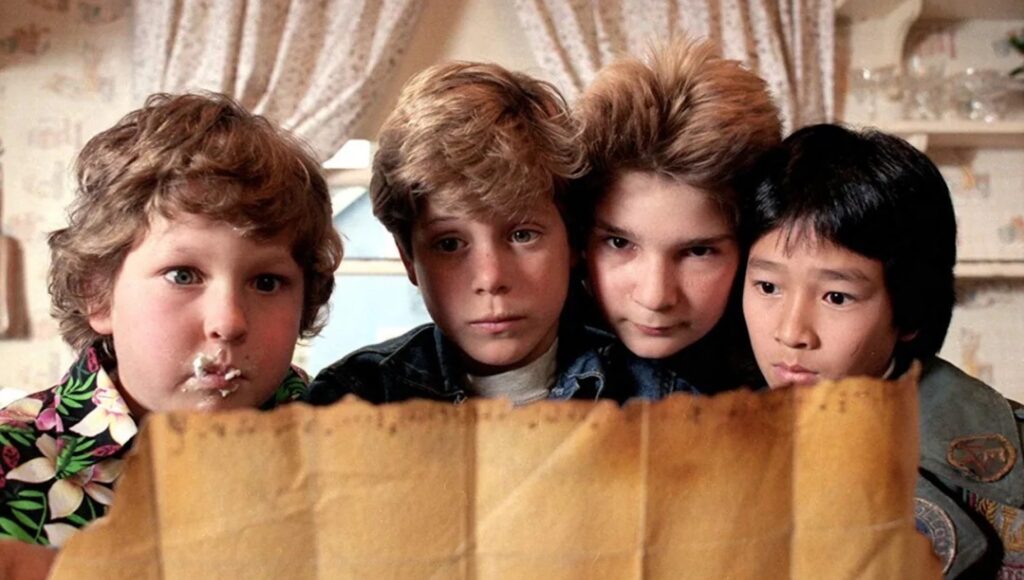
'The Goonies' (1950)
The benefits of using character archetypes include:
- Universality : Archetypes are universally understood and have similar meanings across cultures and historical contexts. This can especially help in the cinematic realm as movies are released in multiple countries and languages.
- Symbolism : These character traits can symbolize a particular aspect of human experience or life. Once again, symbolism is identifiable across many cultures.
- Predictability : Because they are based on common patterns, their behaviors and roles in stories can often be anticipated . Because of that anticipation, writers can choose between subverting those expectations or using the predictability of the archetypes to service the story and protagonist with ease.
- Variability : While archetypes are typical patterns, they allow for variations and depth, meaning a single archetype can manifest in different ways across various stories, allowing writers can adapt these traits to any character.
Character archetypes can be used as tools to tell a compelling and universal story.

'Finding Nemo' (2003)
What Are the Character Archetypes in the Hero's Journey?
Many archetypes in the hero's journey—the threshold guardian, the herald, the shapeshifter, the trickster, the ally, and the tempter/temptress—are more defined in later interpretations and expansions of Campbell's work. People like Vogler applied his theories to modern storytelling so writers, readers, and audiences could more easily understand the dynamics of Campbell’s monomyth.
Here, we’ll break down the main character archetypes in the hero's journey utilized in Campbell’s Monomyth and Vogler’s expanded breakdowns and interpretations.
The hero is the central figure of the story (protagonist) who undergoes a journey, facing challenges and transformations. The hero often starts as an ordinary person who is then called to adventure. They are present throughout the entire journey , from the ordinary world to the return with newfound knowledge or power.
Luke Skywalker (Star Wars), Indiana Jones ( Raiders of the Lost Arc ), Katniss Everdeen ( The Hunger Games ), Barbie ( Barbie ), and Harry Potter (the Harry Potter series) are perfect examples of the hero character archetypes. You can include any protagonist within a story that goes on a physical or emotional journey.
As mentioned above, the hero in the hero’s journey usually begins their adventure within their ordinary world. This offers readers and audiences the chance to relate to the protagonist, empathize with their plight, and see the beginning of their character arc.
Read More: Why the 'Barbie' Movie is the Perfect Example of the Hero’s Journey
The shadow is the main antagonist of the story. The shadow reflects the darker aspects of the hero, sometimes represented as the mirror image (opposite) of the hero and their beliefs. Overall, they are the antagonist or villains present throughout the whole story in varied ways.
Read More: 15 Types of Villains Screenwriters Need to Know
The shadow can also be represented in metaphorical terms. If a story’s hero journey is the protagonist dealing with alcoholism or addiction, those vices can serve as the shadow/antagonist/villain.
The quintessential shadows in cinema include characters like Darth Vader ( Star Wars ), Voldemort (the Harry Potter series), and Sauron ( The Lord of the Rings series). But you can also find a less villainous shadow that takes on a lighter antagonistic role without purely evil intentions.
A perfect example of that would be Principal Rooney in Ferris Bueller’s Day Off . He doesn’t have evil intentions like a villain does. However, he is the shadow or mirror image of Ferris Bueller. Ferris believes in freedom an expression . Rooney believes in order and control of others.

'Ferris Bueller's Day Off' (1986)
This character serves as a guide or teacher to the hero, providing them with advice, training, or magical assistance. The mentor is often a wise or experienced figure, although there have been literary and cinematic variances.
Look no further than the likes of Obi-Wan Kenobi ( Star Wars ), Yoda ( The Empire Strikes Back ), Mr. Miyagi ( The Karate Kid ), and Gandalf ( The Lord of the Rings series ) as core examples of the mentor.
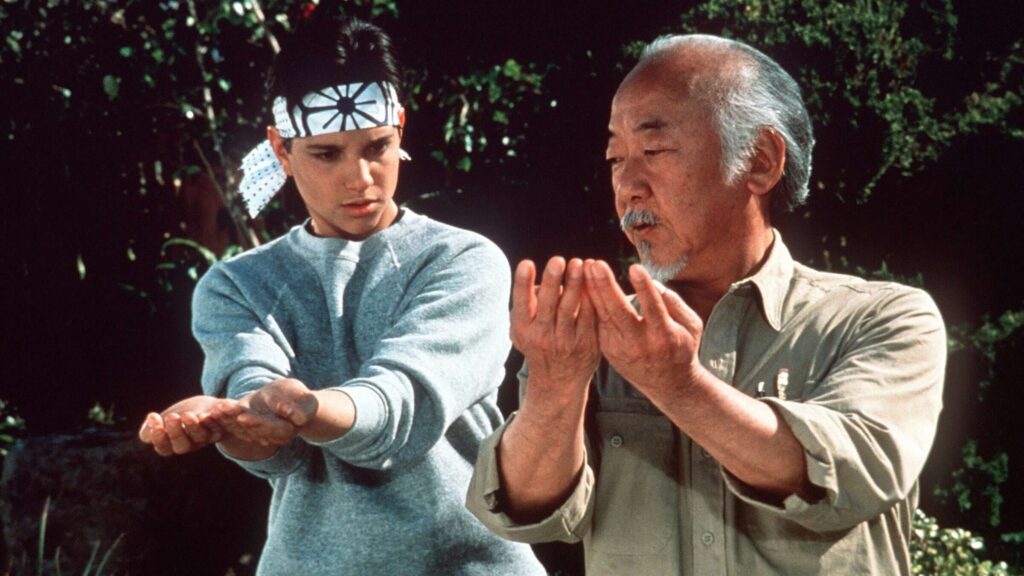
'The Karate Kid' (1984)
Allies are friends or companions who support and accompany the hero through their journey. They often complement the hero's skills and help them face challenges.
In Star Wars , the allies of Luke Skywalker include Han Solo, Chewbacca, and the droids. In The Lord of the Rings series , the fellowship companions of Frodo encompass this character archetype. You can also look to any sidekick-type character as the perfect example of an ally:
- Goose in Top Gun
- Patrick in Spongebob Squarepants
- Ron in Harry Potter
- Billy in Big
- Julie in Lady Bird
- Rod in Get Out
- Ned in the Spider-Man movies
- Sam in The Lord of the Rings
- Short Round in Indiana Jones and the Temple of Doom
Allies can also be characters who aren’t as close to the hero but offer some type of help along the way.

'Lady Bird' (2017)
The Threshold Guardian
These characters serve as obstacles the hero must overcome or circumvent on their journey. They are not always enemies but are present within the story to test the hero and give them the belief and ability to continue on their adventure.
Little John in the Robin Hood stories is initially the threshold guardian of the Sherwood Forest.
He eventually becomes an ally to Robin. But he’s initially a threshold guardian.
You can turn to Monthy Python and the Holy Grail as well. The Black Knight isn’t necessarily King Arthur’s foe. However, he’s there to defend the bridge at all costs.
The Herald
The herald is the character that initiates the call to adventure, pushing the hero to action, or providing the news or event that triggers their journey.
In Star Wars , R2-D2 is the herald of Luke’s journey because he delivers the message from Princess Leia to him . If Luke doesn’t see that message, he doesn’t show it to Obi-Wan Kenobi. And if Obi-Wan doesn’t see that message, he doesn’t convince Luke to come with him to join the Rebellion.
In Barbie , Weird Barbie is the one who tells Barbie the truth about what she is going through and what she must do to seek out the answers she needs.
The herald can be a major character, a supporting character, or even a minor character. In The Lord of the Rings , Gandalf is both mentor and herald, as he is the one who appears to Frodo, telling him he must bring the ring to Mordor.
The Shapeshifter
This archetype's loyalty and role are often unclear, and they can serve as an ally or an enemy to the hero. Sometimes both. Their unpredictable nature adds complexity to the story, usually resulting in twists and turns within the plot.
Snape in the Harry Potter series is one of the greatest shapeshifters in literature and film. His motives are unknown, mistaken, and hidden. He acts as both a shadow to Harry and later an ally.
Jack Sparrow in the Pirates of the Caribbean series is another great example, embodying the role of an unpredictable ally whose loyalty is often questionable. Yes, he can be looked upon as an antihero protagonist of the movie. However, the clear hero of the story is Will.

'Pirates of the Caribbean: The Curse of the Black Pearl' (2003)
The Trickster
The trickster usually adds levity to the story through comic relief. They can be allies or enemies, but typically they cause trouble for both.
Jack Sparrow falls under this character archetype as well. But a better example may be Loki in the Marvel Cinematic Universe movies. He embodies the definition of a trickster. He brings more comic relief to the movies after his initial first appearance in Thor .
Perhaps the better example would be Genie in Disney's Aladdin . He uses his powers for humorous and unexpected effects, often bending the rules and adding a lighthearted element to the story.
Tempter/Temptress
This archetype can be of any gender and represents temptation or distraction that diverts the hero from their path.
Catwoman in the Batman movies often plays the role of a temptress to Batman, combining allure with a morally ambiguous character.
Many of the Bond Girls in the James Bond films serve as temptresses, combining allure and mystery and often leading Bond into dangerous situations.
The Indiana Jones variation would be Elsa from Indiana Jones and the Last Crusade .
One of the best examples of the Tempter playing a more pivotal role in the story is Avery Tolar in The Firm . He’s a senior partner at the law firm Bendini, Lambert & Locke. His role is crucial in seducing the protagonist, Mitch McDeere, into the luxurious and corrupt world of the law firm.
He has a charismatic and persuasive personality. He mentors Mitch and exposes him to the high-stakes, high-reward lifestyle that the firm offers, including wealth, prestige, and power. Tolar's character is complex. He is a nuanced character who embodies the charm and allure that the firm uses to entice and trap its young associates.
His influence on Mitch is significant, as he represents the allure of success and the moral compromises that often accompany it. Tolar's character effectively demonstrates how the tempter archetype can be used to explore themes of corruption, temptation, and ethical dilemmas in a narrative.
The character archetypes found within the h ero’s journey offer writers the ability to take universal character templates and mold them to fit into stories that embrace the monomyth structure or use it as a starting point to tell a compelling and engaging story.
Use them in whatever way you’d like. They can encompass the more traditional definition within your story, or you can use these archetypes to set up expectations and later subvert those expectations to create a more enthralling and surprising plot.
Read More: Is Joseph Campbell's "The Hero's Journey" Dead in Screenwriting Today?
CHECK OUT OUR PREPARATION NOTES SO YOU START YOUR STORY OFF ON THE RIGHT TRACK!

Ken Miyamoto has worked in the film industry for nearly two decades, most notably as a studio liaison for Sony Studios and then as a script reader and story analyst for Sony Pictures.
He has many studio meetings under his belt as a produced screenwriter, meeting with the likes of Sony, Dreamworks, Universal, Disney, Warner Brothers, as well as many production and management companies. He has had a previous development deal with Lionsgate, as well as multiple writing assignments, including the produced miniseries Blackout, starring Anne Heche, Sean Patrick Flanery, Billy Zane, James Brolin, Haylie Duff, Brian Bloom, Eric La Salle, and Bruce Boxleitner, the feature thriller Hunter’s Creed, and many Lifetime thrillers. Follow Ken on Twitter @KenMovies and Instagram @KenMovies76
Get Our Screenwriting Newsletter!
Get weekly writing inspiration delivered to your inbox - including industry news, popular articles, and more!
Facebook Comments
Free download.

Screenwriting Resources:

$ 15.00 $ 12.00 Add to cart
Popular Posts

Recent Posts
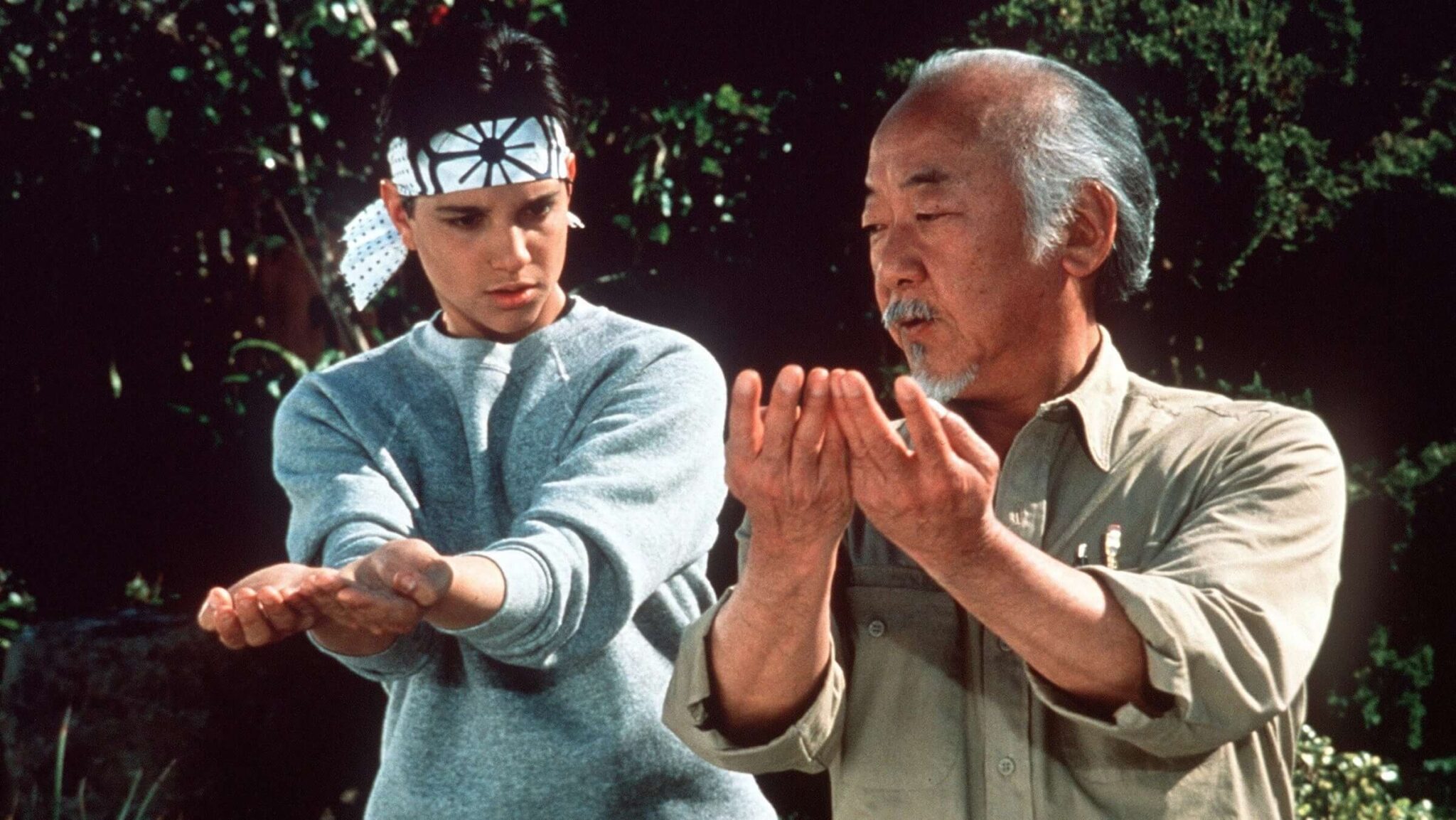
Next Related Post

Get Our Newsletter!
Developing your own script.
We'll send you a list of our free eCourses when you subscribe to our newsletter. No strings attached.
You Might Also Like

- Hidden Name
- Comments This field is for validation purposes and should be left unchanged.
Connect With Us
Writing competitions, success stories.
© 2024 ScreenCraft | An Industry Arts Company
Wait! Subscribe to get our free Newsletter
Join our community of over 100,000 screenwriters and get weekly inspiration delivered to your inbox.
Screenwriting Newsletter
Join our community of over 100,000 screenwriters and get weekly inspiration delivered to your inbox:
✓ Popular blog posts and industry news ✓ New ScreenCraft online events ✓ Screenplay competition announcements!
" * " indicates required fields

IMAGES
VIDEO
COMMENTS
The Hero. Within the ordinary world you are introduced to Telemachus, the troubled hero who lost his father. He faces conflict and needs to find a solution. Threshold Guardian. Herald. The Herald in this instance is Athena. She tells Telemachus that his father may still be alive which is what spurs him to go on the journey. Refusal of the Call ...
Telemachus, a central character in Homer's Odyssey, has an important role in Greek mythology as more than just the son of Odysseus and Penelope. His story is one of growth, wisdom, and heroism. He embarks on a journey to find his father who has been absent from his life since leaving to fight in the Trojan War.
Nestor, king of Pylos, tells Telemachus (Odysseus's son) about the Trojan War. See all videos for this article. Telemachus, in Greek mythology, son of the Greek hero Odysseus and his wife, Penelope. When Telemachus reached manhood, he visited Pylos and Sparta in search of his wandering father. On his return, he found that Odysseus had reached ...
Telemachus Arming by Luigi Bienaimé, 1835, via Sotheby's. Telemachus and Mentor-Athena set off on a journey to visit the great kings of Greece, who were old friends and comrades of Odysseus. This is the beginning of the hero's coming-of-age narrative. His first stop is at the kingdom of Nestor, in Pylos.
Telemachus never fully matches his father's talents, at least not by The Odyssey 's conclusion. He has a stout heart and an active mind, and sometimes even a bit of a temper, but he never schemes with the same skill or speaks with quite the same fluency as Odysseus. In Book 22, he accidentally leaves a weapons storeroom unlocked, a careless ...
By clark January 11, 2022. Telemachus in The Odyssey played a small but crucial role in Homer's Classic. The Homeric classic plays the son of our missing hero, Odysseus, and strongly believes in his father's survival. His resolution and loyalty to his father run deep enough to journey far and wide to find his whereabouts.
Telemachus: The Odyssey's Unsung Hero. Evangelia. September 20, 2023. Telemachus is often overshadowed by his legendary father, Odysseus. However, this young hero has a tale worth telling. Let's embark on a journey to discover the intricacies of his life, his challenges, and his growth throughout the epic of The Odyssey. Table of Contents.
Joseph Campbell's Hero's Journey, while based on his study of mythology around the world, can be applied to more than just myth. In fact, it's applied to film frequently. One of the clearest examples of Campbell's Hero's Journey is none other than George Lucas's film Star Wars: A New Hope (1977). To this film we now turn.
Hello Folks,This time we'll be looking at the journey of Odysseus' son Telemachus in the first four books of Homer's Odyssey (a.k.a the Telemachy). This is a...
Upon their arrival home, Odysseus and Telemachus carry out the brutal slaughter of the suitors. After this event takes place, reality sets in and life returns to its normal state. Telemachus' last reward, on his complete journey, was his maturity, and how he transitioned from being a boy to becoming a man.
Telemachus Journey From Boyhood to Hero: Homer's The Odyssey Essay. As described by Arnold van Gennep in "The rites of Passage," the concept of the rites of passage is a ritual event used to signify the process of transition of a person from one social or cultural status to another (Gennep 23). Arnold van Gennep states that the concept of ...
In Greek mythology, Odysseus, also known as Ulisses, is a prominent character and the hero of Homer's epic poem, the Odyssey. He was the king of Ithaca, known for his bravery, intelligence, and leadership. Odysseus played a crucial role in the Trojan War and embarked on a journey filled with trials and adventures.
The journey of Telemachus follows many of the stages in "The Hero's Journey." His story starts at his father Odysseus' palace, in the ordinary world. Here, we are introduced to Telemachus and his dilemma: suitors are taking over his house in the absence of his father. Next, Athena presents Telemachus with a call to adventure, saying, "I have ...
1. The Ordinary World. Click the card to flip 👆. -Telemachus is stuck at home being taken over by suitors. -Longs to find Odysseus and get him back in power. Click the card to flip 👆. 1 / 12.
A hero's journey is defined as a hero who journeys on an adventure, along the way learning a lesson and winning the overarching conflict of the journey. Odysseus' hero's journey starts in Homer's epic, The Iliad, which depicts Odysseus' call to adventure with the start of the Trojan War. On the contrary, Telemachus' hero's journey is ...
Telemachus on the Hero's Journey. The Call to Adventure. Click the card to flip 👆. -Athena comes to tell Telemachus to embark on an adventure to Pylos to find Odysseus. Click the card to flip 👆. 1 / 8.
Telemachus Hero's Journey Essay. A hero can be defined in many different ways, such as a man or woman who performs tasks otherwise not able to be performed by a normal human being. Telemachus is a different breed of hero compared to our modern day Superman and Batman. Telemachus is a leader that is seen by the public eye, and also the son of a ...
These stages will focus on Ulysses and his son Telemachus. According to Joseph Campbell, a hero's journey normally entails three phases; the departure, the initiation, and the return. (Wikipedia) The first phase is the departure phase, which consists of three stages; the call to adventure, the refusal of the call, and supernatural aid.
Christopher Vogler's Interpretation of the Hero's Journey. When Christopher Vogler, a development executive and screenwriter at Disney, was inspired by Joseph Campbell's concept of the story monomyth, he crafted a seven-page memo for Disney's development team and incoming screenwriters. This memo, A Practical Guide to Joseph Cambell's The Hero with a Thousand Faces, laid the groundwork for ...